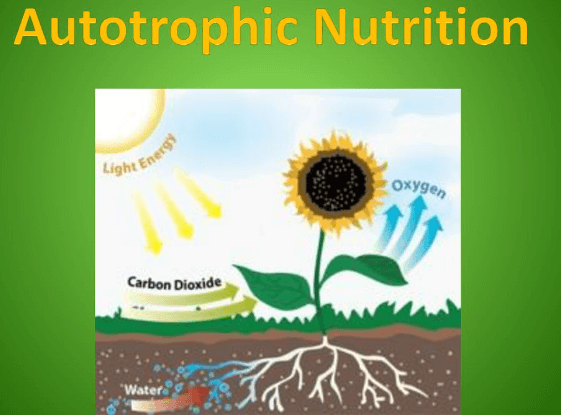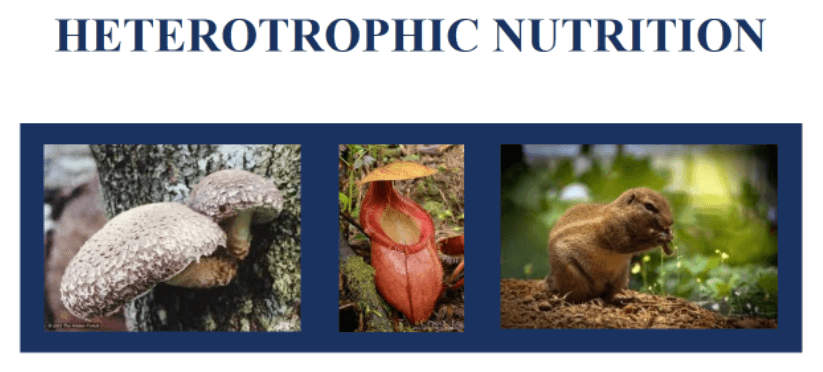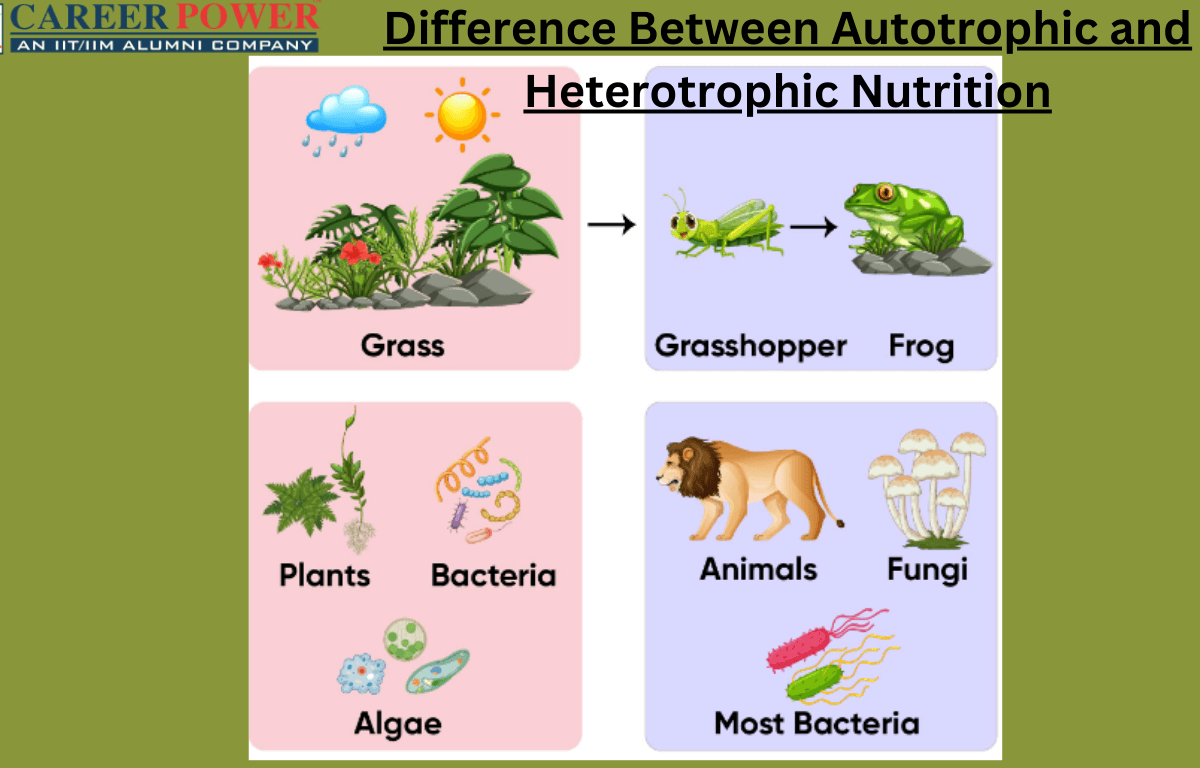As we know there are two types of Nutrition: Autotrophic and Heterotrophic nutrition. Autotrophic nutrition involves organisms, like plants, producing their own organic molecules from inorganic sources through processes like photosynthesis. Heterotrophic nutrition, on the other hand, relies on the consumption of pre-formed organic matter from other organisms. The key difference lies in the organism’s ability to either create its own food (autotrophy) or acquire it from external sources (heterotrophy).
Autotrophic and Heterotrophic Nutrition
Living organisms obtain energy and nutrients through two different modes namely Autotrophic and Heterotrophic Nutrition. Where Autotrophic organisms produce their own food through photosynthesis, while Heterotrophic organisms obtain their food by consuming other organisms or organic matter. These two modes of nutrition are fundamental to the energy flow in ecosystems, as autotrophs provide the base of the food chain, and heterotrophs rely on them for sustenance.
What is Autotrophic Nutrition?
Autotrophic nutrition is a mode of nutrition in which organisms are capable of producing their own organic molecules, primarily glucose, from inorganic sources such as carbon dioxide (CO2) and water (H2O). This process, known as photosynthesis, typically involves the use of sunlight as an energy source and occurs in green plants, algae, and some bacteria. This process is fundamental to sustaining life on Earth and serves as the basis for many ecosystems.

Autotrophic nutrition is not limited to plants but can also be found in various photosynthetic bacteria and some protists. These organisms have specialized structures and organelles, such as chloroplasts, to carry out photosynthesis. Autotrophs form the foundation of the food chain’s ecosystems. They provide the initial source of energy and organic matter, which is then consumed by heterotrophic organisms.
What is Heterotrophic Nutrition?
Heterotrophic Nutrition is a type of nutrition in which organisms cannot synthesize their own organic molecules from inorganic sources and must obtain pre-formed organic molecules by consuming other organisms or organic matter. This mode of nutrition is observed in animals, fungi, and many bacteria. Heterotrophs obtain energy by breaking down complex organic compounds, such as carbohydrates, proteins, and fats, through processes like digestion and cellular Respiration. They depend on autotrophs (plants and other photosynthetic organisms) as a source of organic molecules and energy.

Difference Between Autotrophic and Heterotrophic Nutrition
The table below highlights the fundamental distinctions between autotrophic and heterotrophic nutrition, emphasizing how they obtain energy and nutrients and their roles in ecosystems.
| Difference Between Autotrophic and Heterotrophic Nutrition | ||
| Characteristics | Autotrophic Nutrition | Heterotrophic Nutrition |
| Definition | Autotrophic nutrition is nutrition where organisms produce their own organic molecules from inorganic sources. | Heterotrophic Nutrition is nutrition where organisms obtain organic molecules by consuming other organisms or organic matter. |
| Primary Process | In autotrophic nutrition photosynthesis is the primary process. | In heterotrophic nutrition ingestion and digestion are primary processes. |
| Energy Source | Sunlight is the primary energy source in autotrophic nutrition. | Energy is obtained from consumed organic matter in heterotrophic nutrition. |
| Examples | Examples of autotrophic nutrition are Plants, algae, and some bacteria. | Examples of heterotrophic nutrition are animals, fungi, and many bacteria. |
| Carbon Source | In autotrophic nutrition carbon dioxide (CO2) is fixed from the atmosphere. | Organic compounds in the food are the source of carbon. |
| Oxygen Production | Oxygen is released as a byproduct in autotrophic nutrition. | Oxygen is consumed during respiration in heterotrophs. |
| Role in Ecosystems | The autotrophs form the base of the food chains. They provide energy and organic matter. | Heterotrophs occupy various trophic levels and rely on autotrophs for sustenance. |
| Energy storage | Energy is stored in the form of glucose and other organic molecules. | Energy is stored in the chemical bonds of consumed organic compounds. |
| Special Structures or Organelles | Chloroplasts and pigments like chlorophyll are involved in photosynthesis. | Specialized digestive organs and enzymes are involved in digestion. |
| Dependence on other Organisms | Autotrophs are not dependent on other organisms for their energy needs. | Heterotrophs rely on autotrophs or other heterotrophs for their energy needs. |
Functions of Autotrophic and Heterotrophic Nutrition
Both autotrophic and heterotrophic nutrition serve distinct functions in living organisms and ecosystems. Autotrophic nutrition is primarily responsible for producing organic molecules and oxygen, serving as the foundation of food chains and the carbon cycle. Heterotrophic nutrition involves the consumption of organic matter, energy extraction, nutrient recycling, and diverse trophic interactions, contributing to the complexity and dynamics of ecosystems.
Functions of Autotrophic Nutrition
Some of the functions of Autotrophic nutrition have been mentioned below.
- Production of Organic Molecules: Autotrophic organisms, such as plants, algae, and some bacteria produce organic molecules like glucose through photosynthesis. These molecules serve as a source of energy and carbon for the organism itself.
- Oxygen Production: As a byproduct of photosynthesis, autotrophs release oxygen into the atmosphere, which is essential for the preparation of many heterotrophic organisms, including animals.
- Foundation of Food Chains: Autotrophs form the primary trophic level in Food Chains. They provide the initial source of energy and organic matter for ecosystems. Herbivores feed on autotrophs and in turn, carnivores and omnivores consume herbivores, establishing the basis of energy transfer in ecosystems.
- Carbon fixation: Autotrophic organisms play a critical role in the Carbon Cycle. They fix carbon dioxide from the atmosphere into organic compounds, aiding in the removal of excess CO2 from the environment.
- Primary Producers: Autotrophs are often referred to as primary producers because they generate the initial biomass in ecosystems. This biomass is the starting point for the flow of energy through food chains.
Functions of Heterotrophic Nutrition
We have discussed a few functions of the Heterotrophic Nutrition below.
- Consumption of Organic Matter: Heterotrophic organisms, including animals, fungi, and many bacteria, rely on consuming organic matter produced by autotrophs or other heterotrophs. They cannot produce their own organic molecules from inorganic sources.
- Energy Extraction: Heterotrophs break down complex organic compounds, such as carbohydrates, proteins, and fats, to extract energy through processes like digestion and cellular respiration. This energy is used for growth, maintenance, and Reproduction.
- Nutrient Recycling: Heterotrophic organisms play a crucial role in nutrient cycling. They decompose dead organic matter, returning essential nutrients like nitrogen and phosphorous to the ecosystem, which can be taken up by autotrophs again.
- Diverse Trophic Levels: Heterotrophs occupy various trophic levels in ecosystems, including herbivores (primary consumers), carnivores (secondary and tertiary consumers), and decomposers (breaking down detritus). This diversity in feeding strategies contributes to ecosystem stability and complexity.
- Predator-Prey Relationships: Heterotrophic nutrition involves interactions like predation, where one organism captures and consumes another. These interactions regulate populations and maintain balance in ecosystems.



 50 Vegetables Name for Kids in English a...
50 Vegetables Name for Kids in English a...
 Food Chain: Definition, Types, Examples,...
Food Chain: Definition, Types, Examples,...
 Human Respiratory System: Definition, Di...
Human Respiratory System: Definition, Di...













